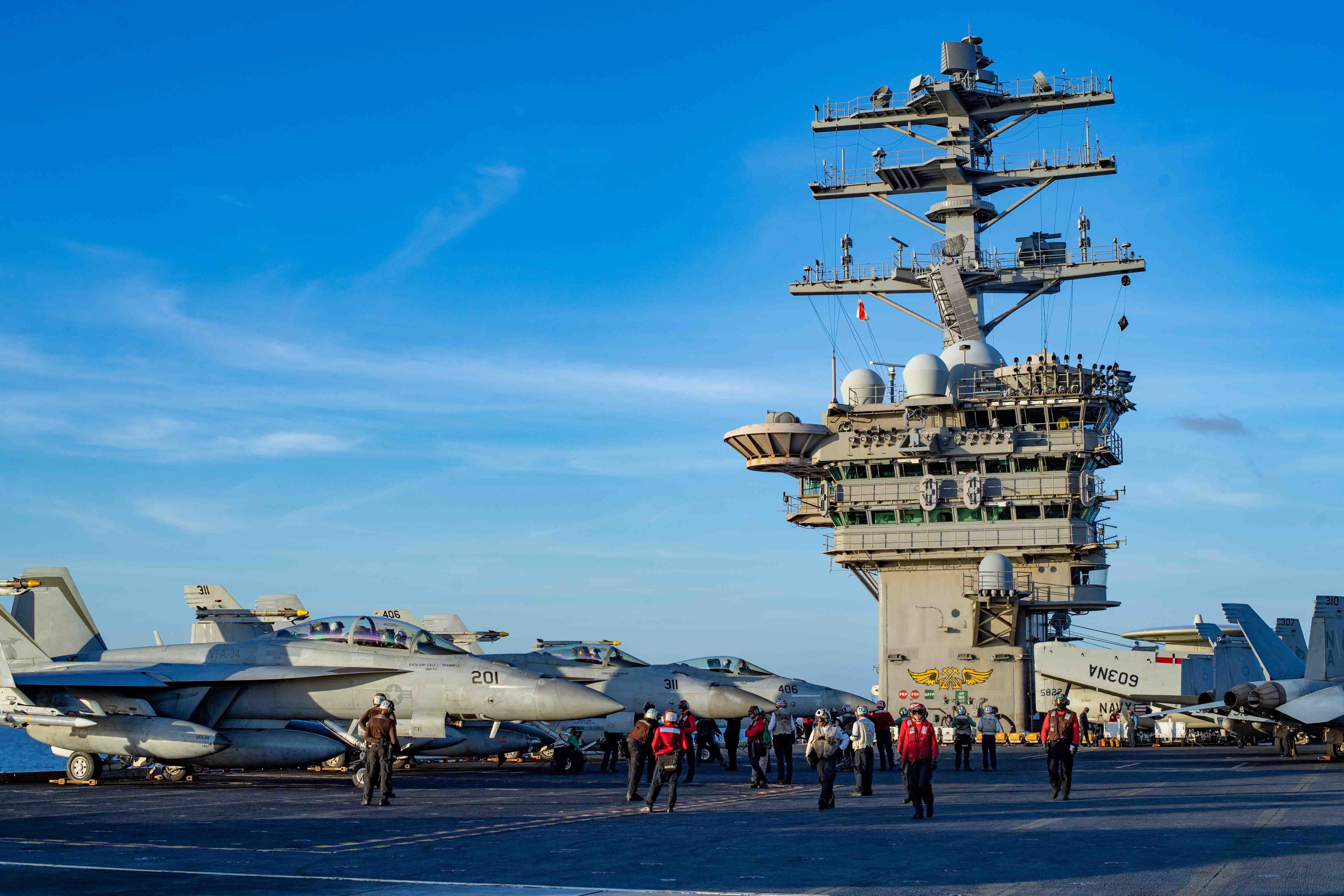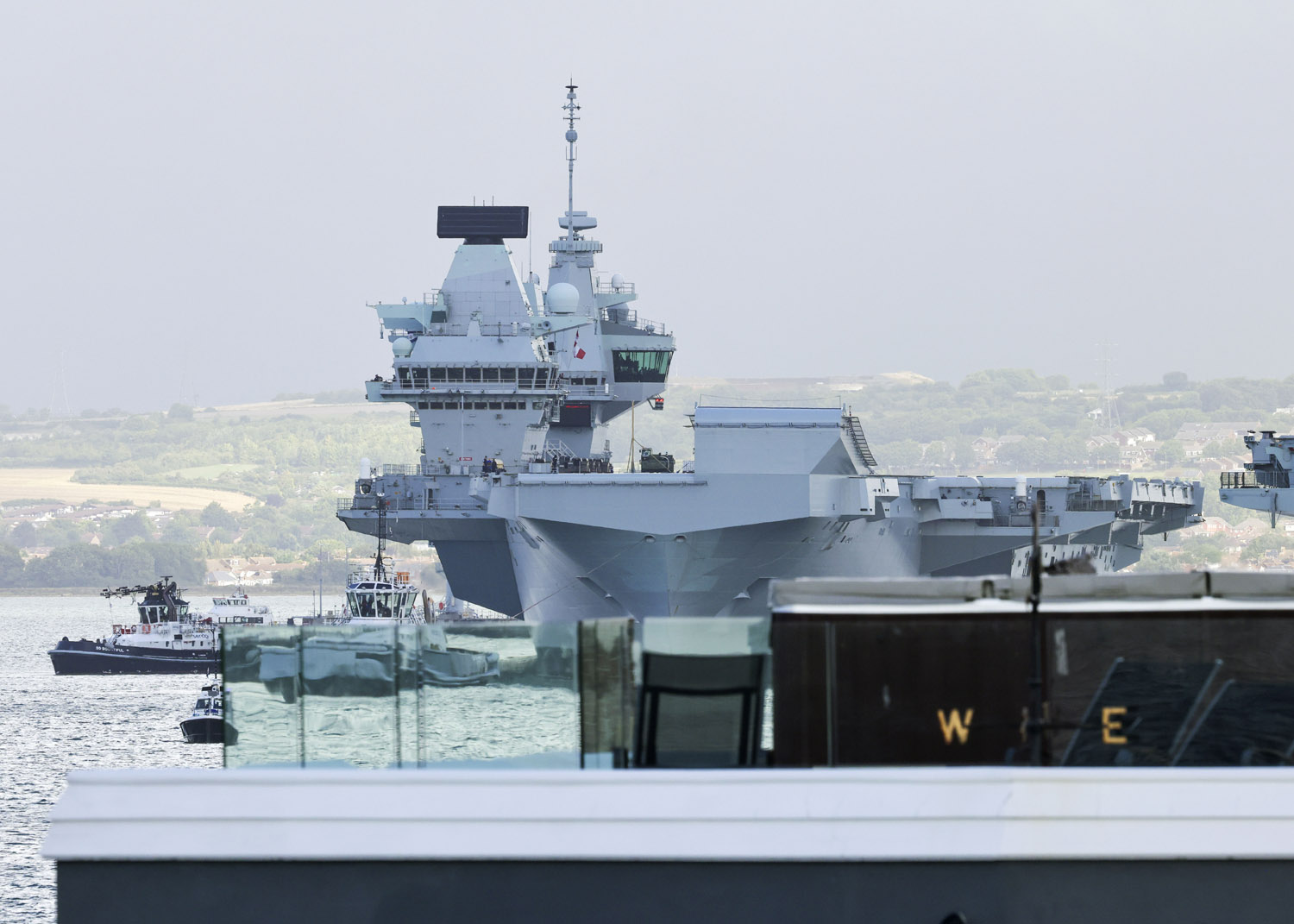Navy Sailors conduct flight operations aboard the aircraft carrier USS Nimitz (CVN-68) on Jan. 13, 2023. US Navy Photo
Aircraft carrier USS Nimitz (CVN-68) pulled into the Japanese port Sasebo Friday as the G-7 conference began in Hiroshima, on Friday according to a Navy statement.
Fleet Activities Sasebo also welcomed destroyer USS Wayne E. Meyer (DDG-108) to the base. The remaining ships in the Nimitz Carrier Strike Group consist of cruiser USS Bunker Hill (CG-52) and destroyers USS Chung-Hoon (DDG-93), USS Decatur (DDG-73) and USS Paul Hamilton (DDG-60).
The other ships in the CSG have been operating in Philippine Sea while Paul Hamilton transited the Strait of Hormuz Friday with U.S. 5th Fleet commander Vice Adm. Brad Cooper, French Vice Adm. Emmanuel Slaars, Joint Commander of the French Forces Deployed in the Indian Ocean and U.K. Royal Navy Commodore Philip Dennis, U.K. Maritime Component Commander aboard, according to the U.S. Navy. The transit by senior commanders comes as the 5th Fleet and partner nations increased their naval patrols the Strait of Hormuz in response to Iran’s recent seizures of merchant vessels.
The U.K. and Japan signed a new agreement on Thursday called the ‘Hiroshima Accord’ which will enhance U.K.-Japan economic, security and tech collaboration as part of U.K. Prime Minister Rishi Sunak’s visit to Japan and attendance at the G-7 summit, according to a release from Sunak’s office. The U.K. also announced the deployment of the Royal Navy Carrier Strike Group to the Indo-Pacific in 2025.
“The U.K. will confirm today that its Carrier Strike Group will return to the Indo-Pacific in 2025, following its maiden voyage to the region in 2021. The fleet, comprised of an aircraft carrier, her escorts and her aircraft, will work alongside the Japanese Self Defence Forces and other regional partners to help defend peace and stability in the Indo-Pacific,” reads the statement.
The statement did not specify which carrier. The Royal Navy’s second carrier HMS Prince of Wales (R09) is undergoing repairs after a failure in in tis propulsion system last year leaving HMS Queen Elizabeth (R08) to fill in.
This week U.K. Defense Minister Ben Wallace told Parliament Prince of Wales, “will be back in full service in the autumn.”
While in Japan, Sunak will confirm new U.K.–Japan defense cooperation, including doubling UK troop numbers in upcoming joint exercises and agreeing to a formal Consult Clause, whereby the U.K. and Japan commit to consult each other on important regional and global security issues and consider measures in response.
The Hiroshima Accord, signed by Sunak and Japan Prime Minister Fumio Kishida Thursday, stated that the two countries “are determined to strengthen the free and open international order based on the rule of law, and to uphold the principles of the U.N. Charter including respect for sovereignty and territorial integrity.”
The U.K. and Japan also called on China to act as a responsible member of the international community and that both countries had serious concerns over the situation in the East China Sea and the South China Sea, and strongly oppose unilateral attempts to change the status quo by force or coercion anywhere in the world.
The defense portion of the Hiroshima Accord agreed for the two countries to maximize the opportunity provided by the Global Combat Air Programme to future proof the combat air sectors of the two countries and strengthen the defense industrial base of both countries through shared expertise and collaboration. Prior to signing the accord, Sunak toured Japan destroyer helicopter carrier JS Izumo (DDH-183) at Yokosuka Naval Base as part of his itinerary and spoke to the media, giving a preview of the Hiroshima Accord.
During the G-7 summit, leaders of the Quad partnership, Australia, India, Japan and the U.S. are expected to hold a meeting in lieu of the canceled May 24 Quad summit in Australia. The meeting was canceled due to U.S. President Joe Biden canceling his trip to Australia due to the ongoing debt ceiling negotiations in the United States. While Australia and India are not part of the G-7, Australian Prime Minister Anthony Albanese and Indian Prime Minister Narendra Modi are attending the G-7 summit as guests.
Ships of the People’s Liberation Army Navy completed sailing around Japan Tuesday ahead of the G-7 meeting. A PLAN Surface Action Group did a circuit of Japan while a PLAN Dongdiao class intelligence ship circuited the main islands of Honshu and Kyushu. Meanwhile, the United Kingdom announced Wednesday that it will deploy a Carrier Strike Group (CSG) to the Indo-Pacific in 2025 along with signing agreements with Japan on enhancing defense cooperation.
On Tuesday, the Joint Staff Office (JSO) of Japan’s Ministry of Defense issued a release stating that Dongdiao class intelligence ship Kaiyangxing (796) was sighted at 3 a.m. that day sailing northwest in an area 75 northeast of Miyako Island and passed through the Miyako into the East China Sea. The intelligence ship was shadowed by a Japan Maritime Self Defense Force (JMSDF) P-3C of Fleet Air Wing 5 based at Naha Air Base, Okinawa.
Kaiyangxing sailed through the Tsushima Strait on April 29 and on May 5 transited the Tsugaru Strait, which separates the main island of Honshu and Hokkaido, and, on May 8, sailed between Sumisu Island and the island of Torishima, which lies south of Japan’s capital of Tokyo. With its transit of the Miyako Strait, the PLAN ship completed a circle of Japan’s main island of Honshu and Kyushu.
On Wednesday, the JSO said the PLAN SAG comprising of cruiser CNS Lhasa (102), destroyers CNS Guiyang (119) and CNS Qiqihar (121), frigate CNS Zaozhuang (542) and fleet oiler CNS Taihu (889).
At 9 a.m. Tuesday, destroyers Guiyang and Qiqihar along with fleet oiler Taihu were sighted sailing northwest in an area 30 miles southeast of Yonaguni Island and subsequently sailed north between Yonaguni Island and Iriomote Island before sailing east. They were sighted sailing northeast in an area 37 miles southeast of Taisho Island. At 7 p.m. the same day, cruiser Lhasa and frigate Zaozhuang were sighted sailing northwest in an area 68 miles northeast of Miyako Island and continued sailing northwest to transit the Miyako Strait.
The two PLAN detachments then joined up to reform the SAG in an area 50 miles west of Kume Island and sailed northwest into the East China Sea. Destroyer JS Suzunami (DD-114) and training ship JS Kurobe (ATS-4202) shadowed the PLAN ships.
The release noted that the PLAN SAG had sailed northeast through the Tsushima Strait April 30, transited west on May 5-6 through La Pérouse Strait, which separates Hokkaido from the Russian island of Sakhalin, and were between Sumisu Island and the island of Torishima from May 11-13. The PLAN SAG completed a circuit of Japan.
PLAN ships routinely sail in the vicinity of Japan though mostly sailing in international waters off Japan and using Japanese straits which are designated as international waterways. The JSO issues regular reports on the movements of Chinese and Russian military ships and aircraft in the vicinity of Japan and its Exclusive Economic Zones with naval and air units shadowing the ships and aircraft of the two countries.







